【译文】M9:基于生物药剂学分类系统的生物等效性豁免[1]
- 格式:pdf
- 大小:542.69 KB
- 文档页数:18
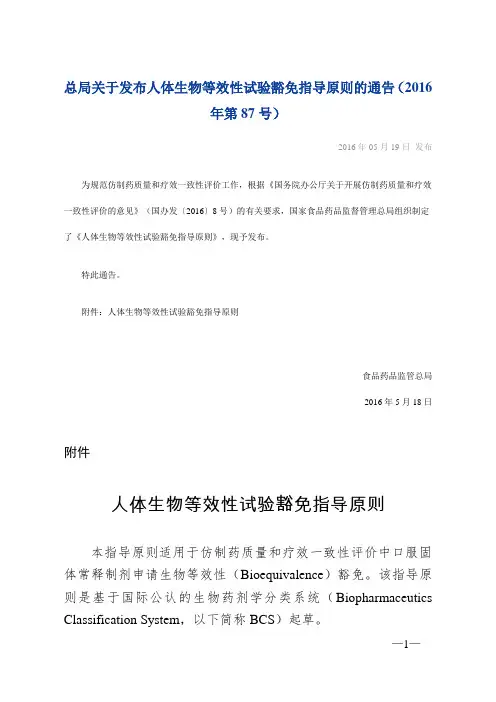
总局关于发布人体生物等效性试验豁免指导原则的通告(2016年第87号)2016年05月19日发布为规范仿制药质量和疗效一致性评价工作,根据《国务院办公厅关于开展仿制药质量和疗效一致性评价的意见》(国办发〔2016〕8号)的有关要求,国家食品药品监督管理总局组织制定了《人体生物等效性试验豁免指导原则》,现予发布。
特此通告。
附件:人体生物等效性试验豁免指导原则食品药品监管总局2016年5月18日附件人体生物等效性试验豁免指导原则本指导原则适用于仿制药质量和疗效一致性评价中口服固体常释制剂申请生物等效性(Bioequivalence)豁免。
该指导原则是基于国际公认的生物药剂学分类系统(Biopharmaceutics Classification System,以下简称BCS)起草。
一、药物BCS分类BCS系统是按照药物的水溶性和肠道渗透性对其进行分类的一个科学架构。
当涉及到口服固体常释制剂中活性药物成分(Active Pharmaceutical Ingredient,以下简称API)在体内吸收速度和程度时,BCS系统主要考虑以下三个关键因素,即:药物溶解性(Solubility)、肠道渗透性(Intestinal permeability)和制剂溶出度(Dissolution)。
(一)溶解性溶解性分类根据申请生物等效豁免制剂的最高剂量而界定。
当单次给药的最高剂量对应的API在体积为250ml(或更少)、pH值在1.0—6.8范围内的水溶性介质中完全溶解,则可认为该药物为高溶解性。
250ml的量来源于标准的生物等效性研究中受试者用于服药的一杯水的量。
(二)渗透性渗透性分类与API在人体内的吸收程度间接相关(指吸收剂量的分数,而不是全身的生物利用度),与API在人体肠道膜间质量转移速率直接相关,或者也可以考虑其他可以用来预测药物在体内吸收程度的非人体系统(如使用原位动物、体外上皮细胞培养等方法)对渗透性进行分类。

美国FDA《特定药物的生物等效性指导原则》高变异性药物生物等效性指导原则调研朱凤昌;王爱国;韩凤;张华吉;丁丽霞【期刊名称】《中国药物评价》【年(卷),期】2016(033)005【摘要】目的:研究美国食品药品管理局(FDA)《特定药物的生物等效性指导原则》对高变异性药物生物等效性研究相关规定,为我国仿制药质量和疗效一致性评价工作提供借鉴和帮助.方法:从剂型、给药方式、试验设计、受试者选择、给药条件、检测物质选择、豁免条件、体外溶出试验等多个方面对美国FDA公布的高变异性药物《特定药物的生物等效性指导原则》进行详细分析,并特别指出涉及我国仿制药质量与疗效一致性评价首批品种的高变异性药物.结果:美国FDA公布的涉及高变异性药物《特定药物的生物等效性指导原则》对具体化学仿制药的生物等效性评价从多个方面进行较为详细的规范,是对美国FDA相关生物等效性总则的补充和解读,对仿制药的发展有重要的推动作用.结论:在我国国家食品药品监督管理总局(CFDA)尚未颁布针对具体高变异性药物相关生物等效性指导原则的背景下,美国FDA《特定药物的生物等效性指导原则》中对高变异性药物相关规范对我国正在进行的仿制药质量和疗效一致性评价具有一定指导和借鉴意义.【总页数】5页(P397-401)【作者】朱凤昌;王爱国;韩凤;张华吉;丁丽霞【作者单位】中国药学会,北京100022;中国药学会,北京100022;中国药学会,北京100022;中国药学会,北京100022;中国药学会,北京100022【正文语种】中文【中图分类】R965【相关文献】1.《以药动学参数为终点评价指标的化学药物仿制药人体生物等效性研究技术指导原则》解读 [J], 施孝金2.美国FDA生物等效性指导原则的修订与仿制药一致性评价 [J], 薛晶;南楠;刘倩;许鸣镝3.高变异性药物生物等效性研究指南的对比解析 [J], 束俭辉;赵晶晶;过芳4.国家药监局发布生物等效性研究的统计学指导原则和高变异药物生物等效性研究技术指导原则 [J],5.药审中心公开征求ICH指导原则《M9:基于生物药剂学分类系统的生物等效性豁免》意见 [J],因版权原因,仅展示原文概要,查看原文内容请购买。
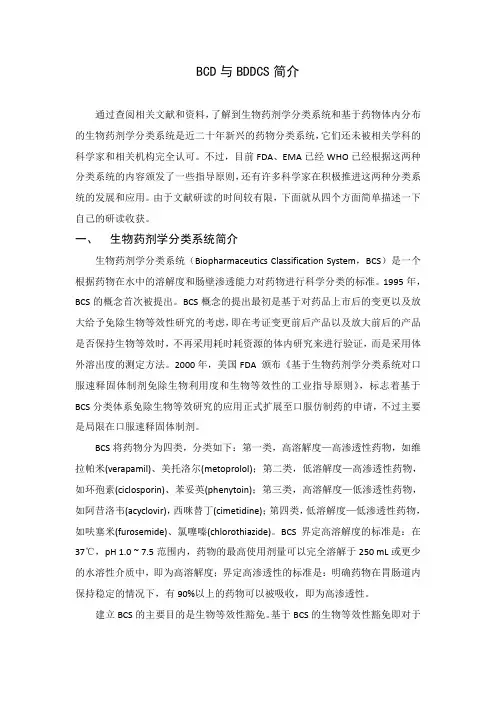
BCD与BDDCS简介通过查阅相关文献和资料,了解到生物药剂学分类系统和基于药物体内分布的生物药剂学分类系统是近二十年新兴的药物分类系统,它们还未被相关学科的科学家和相关机构完全认可。
不过,目前FDA、EMA已经WHO已经根据这两种分类系统的内容颁发了一些指导原则,还有许多科学家在积极推进这两种分类系统的发展和应用。
由于文献研读的时间较有限,下面就从四个方面简单描述一下自己的研读收获。
一、生物药剂学分类系统简介生物药剂学分类系统(Biopharmaceutics Classification System,BCS)是一个根据药物在水中的溶解度和肠壁渗透能力对药物进行科学分类的标准。
1995年,BCS的概念首次被提出。
BCS概念的提出最初是基于对药品上市后的变更以及放大给予免除生物等效性研究的考虑,即在考证变更前后产品以及放大前后的产品是否保持生物等效时,不再采用耗时耗资源的体内研究来进行验证,而是采用体外溶出度的测定方法。
2000年,美国FDA 颁布《基于生物药剂学分类系统对口服速释固体制剂免除生物利用度和生物等效性的工业指导原则》,标志着基于BCS分类体系免除生物等效研究的应用正式扩展至口服仿制药的申请,不过主要是局限在口服速释固体制剂。
BCS将药物分为四类,分类如下:第一类,高溶解度—高渗透性药物,如维拉帕米(verapamil)、美托洛尔(metoprolol);第二类,低溶解度—高渗透性药物,如环孢素(ciclosporin)、苯妥英(phenytoin);第三类,高溶解度—低渗透性药物,如阿昔洛韦(acyclovir),西咪替丁(cimetidine);第四类,低溶解度—低渗透性药物,如呋塞米(furosemide)、氯噻嗪(chlorothiazide)。
BCS界定高溶解度的标准是:在37℃,pH 1.0 ~ 7.5范围内,药物的最高使用剂量可以完全溶解于250 mL或更少的水溶性介质中,即为高溶解度;界定高渗透性的标准是:明确药物在胃肠道内保持稳定的情况下,有90%以上的药物可以被吸收,即为高渗透性。

202211一、概述国家药品监督管理局药品审评中心2021年2月发布了《已上市化学药品药学变更研究技术指导原则(试行)》,规定口服固体制剂的多种药学变更情形均需进行变更前后样品的溶出曲线对比研究,如变更制剂处方中的辅料的重大变更、中等变更及部分微小变更,变更生产工艺的重大变更、中等变更,变更生产地址,变更生产批量,变更制剂所用原料药的供应商,变更可能影响制剂关键质量属性的原料药的晶型、粒度等,增加规格等。
变更前后溶出曲线不一致的,均应按照重大变更申报补充申请,监管机构根据研究资料进行综合评估。
为更好地指导企业进行药学变更研究,统一技术要求,对该指导原则中溶出曲线的研究进行解读。
国内已发布的个药指导原则规定了溶出曲线研究的,应参考执行,个药指导原则未明确部分可参考本问答执行。
如变更前产品为基于生物药剂学分类系统等豁免生物等效性试验上市的药物,变更后仍需符合相关的豁免原则(如,ICH M9等)。
注册标准中的溶出度检查方法应在注册上市时进行了科学的研究。
有些上市较早的口服固体制剂的注册标准中没有溶出度检查项,申请人在进行变更时,需进行相应的研究,拟定合理的检测方法。
本问答是基于当前的认知,如有更合理的方法,可进一步完善。
二、普通口服固体制剂的溶出曲线研究1.研究样品如何选择建议选择变更后三批样品与变更前样品的代表性批次(如临床试验批、BE批或其他代表性批次)进行对比研究。
2.溶出介质如何选择建议至少在三种溶出介质(0.1mol/L盐酸或pH1.2盐酸、pH4.5缓冲液、pH6.8缓冲液)中进行研究。
如标准介质(指注册标准所用介质)与以上介质不同,需增加在标准介质中的溶出曲线研究。
对于溶解度受pH值影响较大的药物,可能还需要在更多种pH值的溶出介质中进行考察。
溶出介质的配制建议参考《普通口服固体制剂溶出度试验技术指导原则》进行。
某些标准介质中可能含有少量表面活性剂,除标准介质外,其余介质通常不建议添加表面活性剂,需提供不加表面活性剂的溶出曲线研究数据,并进行相似性评估。

人体生物等效性试验豁免指导原则集团文件版本号:(M928-T898-M248-WU2669-I2896-DQ586-M1988)附件人体生物等效性试验豁免指导原则本指导原则适用于仿制药质量和疗效一致性评价中口服固体常释制剂申请生物等效性(Bioequivalence)豁免。
该指导原则是基于国际公认的生物药剂学分类系统(Biopharmaceutics Classification System,以下简称BCS)起草。
一、药物BCS分类BCS系统是按照药物的水溶性和肠道渗透性对其进行分类的一个科学架构。
当涉及到口服固体常释制剂中活性药物成分(Active Pharmaceutical Ingredient,以下简称API)在体内吸收速度和程度时,BCS系统主要考虑以下三个关键因素,即:药物溶解性(Solubility)、肠道渗透性(Intestinal permeability)和制剂溶出度(Dissolution)。
(一)溶解性溶解性分类根据申请生物等效豁免制剂的最高剂量而界定。
当单次给药的最高剂量对应的API在体积为250ml(或更少)、pH值在1.0—6.8范围内的水溶性介质中完全溶解,则可认为该药物为高溶解性。
250ml的量来源于标准的生物等效性研究中受试者用于服药的一杯水的量。
(二)渗透性渗透性分类与API在人体内的吸收程度间接相关(指吸收剂量的分数,而不是全身的生物利用度),与API在人体肠道膜间质量转移速率直接相关,或者也可以考虑其他可以用来预测药物在体内吸收程度的非人体系统(如使用原位动物、体外上皮细胞培养等方法)对渗透性进行分类。
当一个口服药物采用质量平衡测定的结果或是相对于静脉注射的参照剂量,显示在体内的吸收程度≥85%以上(并且有证据证明药物在胃肠道稳定性良好),则可说明该药物具有高渗透性。
(三)溶出度口服固体常释制剂具有快速溶出的定义是:采用中国药典2015版附录通则(0931)方法1 (篮法),转速为每分钟100转,或是方法2(桨法),转速为每分钟50或75转,溶出介质体积为500ml(或更少),在溶出介质:(1)0.1mol/L HCl或是不含酶的模拟胃液;(2)pH4.5缓冲介质;(3)pH6.8缓冲介质或是不含酶的模拟肠液中,30分钟内API的溶出均能达到标示量的85%以上。
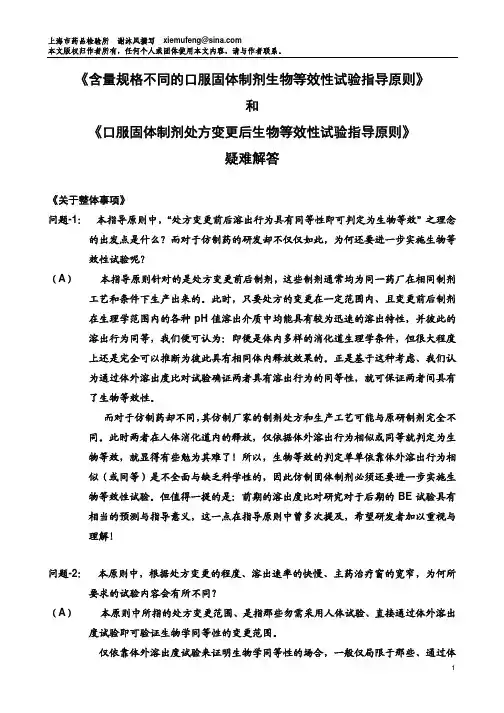
《含量规格不同的口服固体制剂生物等效性试验指导原则》和《口服固体制剂处方变更后生物等效性试验指导原则》疑难解答《关于整体事项》问题-1:本指导原则中,“处方变更前后溶出行为具有同等性即可判定为生物等效”之理念的出发点是什么?而对于仿制药的研发却不仅仅如此,为何还要进一步实施生物等效性试验呢?(A)本指导原则针对的是处方变更前后制剂,这些制剂通常均为同一药厂在相同制剂工艺和条件下生产出来的。
此时,只要处方的变更在一定范围内、且变更前后制剂在生理学范围内的各种pH值溶出介质中均能具有较为迅速的溶出特性,并彼此的溶出行为同等,我们便可认为:即便是体内多样的消化道生理学条件,但很大程度上还是完全可以推断为彼此具有相同体内释放效果的。
正是基于这种考虑、我们认为通过体外溶出度比对试验确证两者具有溶出行为的同等性,就可保证两者间具有了生物等效性。
而对于仿制药却不同,其仿制厂家的制剂处方和生产工艺可能与原研制剂完全不同。
此时两者在人体消化道内的释放,仅依据体外溶出行为相似或同等就判定为生物等效,就显得有些勉为其难了!所以,生物等效的判定单单依靠体外溶出行为相似(或同等)是不全面与缺乏科学性的,因此仿制固体制剂必须还要进一步实施生物等效性试验。
但值得一提的是:前期的溶出度比对研究对于后期的BE试验具有相当的预测与指导意义,这一点在指导原则中曾多次提及,希望研发者加以重视与理解!问题-2:本原则中,根据处方变更的程度、溶出速率的快慢、主药治疗窗的宽窄,为何所要求的试验内容会有所不同?(A)本原则中所指的处方变更范围、是指那些勿需采用人体试验、直接通过体外溶出度试验即可验证生物学同等性的变更范围。
仅依靠体外溶出度试验来证明生物学同等性的场合,一般仅局限于那些、通过体外溶出度试验即可判定出处方变更前后的制剂在消化道内具有相同生理行为的情况。
但对于药物从制剂中缓慢释放的情形、由于其在消化道内受各种生理学因素的影响相当复杂,此时欲建立体内外相关性的难度就要大得多了!正因为如此,对于溶出速率慢的制剂,如仅采用体外溶出度试验来验证生物学同等性的处方变更范围,拟订限度就要比溶出速率快的制剂严格得多、即限度范围小得多!同样,对于治疗窗窄的药物、考虑到采用溶出度试验验证生物学同等性的风险,遂规定允许处方变更的范围亦相当之窄。

Waiver of In VivoBioavailability andBioequivalence Studies for Immediate-Release Solid OralDosage Forms Based on a Biopharmaceutics ClassificationSystemGuidance for IndustryDRAFT GUIDANCEThis guidance document is being distributed for comment purposes only. Comments and suggestions regarding this draft document should be submitted within 60 days of publication in the Federal Register of the notice announcing the availability of the draft guidance. Submit electronic comments to . Submit written comments to the Division of Dockets Management (HFA-305), Food and Drug Administration, 5630 Fishers Lane, rm. 1061, Rockville, MD 20852. All comments should be identified withthe docket number listed in the notice of availability that publishes in the Federal Register.For questions regarding this draft document contact (CDER) Mehul Mehta 301-796-1573.U.S. Department of Health and Human ServicesFood and Drug AdministrationCenter for Drug Evaluation and Research (CDER)May 2015BiopharmaceuticsRevision 1Waiver of In VivoBioavailability and Bioequivalence Studies for Immediate-Release Solid OralDosage Forms Based on a Biopharmaceutics ClassificationSystemGuidance for IndustryAdditional copies are available from:Office of Communications,Division of Drug InformationCenter for Drug Evaluation and ResearchFood and Drug Administration10001 New Hampshire Ave., Hillandale Bldg., 4th FloorSilver Spring, MD 20993-0002Phone: 855-543-3784 or 301-796-3400; Fax: 301-431-6353Email: druginfo@/Drugs/GuidanceComplianceRegulatoryInformation/Guidances/default.htmU.S. Department of Health and Human ServicesFood and Drug AdministrationCenter for Drug Evaluation and Research (CDER)May 2015BiopharmaceuticsRevision 1TABLE OF CONTENTSI.INTRODUCTION (1)II.THE BIOPHARMACEUTICS CLASSIFICATION SYSTEM (2)A. Solubility (3)B. Permeability (3)C. Dissolution (3)III. RECOMMENDED METHODOLOGY FOR CLASSIFYING A DRUG SUBSTANCE AND FOR DETERMINING THE DISSOLUTIONCHARACTERISTICS OF A DRUGPRODUCT (3)A. Determining Drug Substance Solubility Class (3)B. Determining Drug Substance Permeability Class (4)1.Pharmacokinetic Studies in Humans (4)2.Intestinal Permeability Methods (5)3.Instability in the Gastrointestinal Tract (7)C. Determining Drug Product Dissolution Characteristics and Dissolution Profile Similarity .. 7 IV.BIOWAIVERS BASED ON BCS (8)V. ADDITIONAL CONSIDERATIONS FOR REQUESTING A BIOWAIVER (9)A. Excipients (9)B. Prodrugs (9)C. Fixed Dose Combinations (10)D. Exceptions (10)1.Narrow Therapeutic Range Drugs (10)2.Products Designed to be Absorbed in the Oral Cavity (10)VI. REGULATORY APPLICATIONS OF THE BCS (11)A. INDs/NDASs (11)B. ANDAs (11)C. Supplemental NDAs/ANDAs (Postapproval Changes) (11)VII. DATA TO SUPPORT A REQUEST FOR BIOWAIVERS (12)A. Data Supporting High Solubility (12)B. Data Supporting High Permeability (12)C. Data Supporting Rapid, Very Rapid, and Similar Dissolution (13)D. Additional Information (13)ATTACHMENT A (14)Waiver of In Vivo Bioavailability and Bioequivalence Studies for 1Immediate-Release Solid Oral Dosage Forms Based on a2Biopharmaceutics Classification System3Guidance for Industry14567This draft guidance, when finalized, will represent the Food and Drug Administration’s (FDA’s) current 8thinking on this topic. It does not create or confer any rights for or on any person and does not operate to 9bind FDA or the public. You can use an alternative approach if the approach satisfies the requirements of 10the applicable statutes and regulations. If you want to discuss an alternative approach, contact the FDA 11staff responsible for implementing this guidance. If you cannot identify the appropriate FDA staff, call 12the appropriate number listed on the title page of this guidance.1314151617I. INTRODUCTION1819This guidance provides recommendations for sponsors of investigational new drug applications20(INDs), and applicants that submit new drug applications (NDAs), abbreviated new drug applications 21(ANDAs), and supplements to these applications for immediate-release (IR) solid oral dosage forms, 22and who wish to request a waiver of in vivo bioavailability (BA) and/or bioequivalence (BE) studies.23These waivers are intended to apply to: (1) subsequent in vivo BA or BE studies of formulations24after the initial establishment of the in vivo BA of IR dosage forms during the IND period, and (2) in 25vivo BE studies of IR dosage forms in ANDAs.2627Regulations at 21 CFR part 320 address the requirements for BA and BE data for approval of drug 28applications and supplemental applications. Provision for waivers of in vivo BA/BE studies29(biowaivers) under certain conditions is provided at 21 CFR 320.22.2 This guidance updates the30guidance for industry on Waiver of In Vivo Bioavailability and Bioequivalence Studies for31Immediate-Release Solid Oral Dosage Forms Based on a Biopharmaceutics Classification System,3 32published in August 2000, and explains when biowaivers can be requested for IR solid oral dosage 33forms based on an approach termed the Biopharmaceutics Classification System (BCS). This1 This guidance has been prepared by the Office of Pharmaceutical Quality and the Office of Translational Sciencesin the Center for Drug Evaluation and Research (CDER) at the Food and Drug Administration.2 In addition to waiver of an in vivo BE requirement under 21 CFR 320.22, there are certain circumstances in whichBE can be evaluated using in vitro approaches under 21 CFR 320.24(b)(6). The scientific principles described in this guidance regarding waiver of an in vivo requirement also apply to consideration of in vitro data under thatregulation. In such circumstances, an in vivo data requirement is not waived, but rather, FDA has determined that in vitro data is the most accurate, sensitive, and reproducible for a product, as required under 21 CFR 320.24(a).Nonetheless, for ease of the reader, in this guidance we will refer to either the decision to waive an in vivo BErequirement under 21 CFR 320.22 or the decision to accept in vitro BE data in accordance with 21 CFR 320.24(a) as a “biowaiver.”3 We update guidances periodically. To make sure you have the most recent version of a guidance, check the FDADrugs guidance Web page at/Drugs/GuidanceComplianceRegulatoryInformation/Guidances/default.htm.34guidance includes biowaiver extension to BCS class 3 drug products, and additional modifications, 35such as criteria for high permeability and high solubility.36In general, FDA’s guidance documents do not establish legally enforceable responsibilities.3738Instead, guidances describe the Agency’s current thinking on a topic and should be viewed only 39as recommendations, unless specific regulatory or statutory requirements are cited. The use of 40the word should in Agency guidances means that something is suggested or recommended, but 41not required.424344II. THE BIOPHARMACEUTICS CLASSIFICATION SYSTEM4546The BCS is a scientific framework for classifying drug substances based on their aqueous solubility 47and intestinal permeability. When combined with the dissolution of the drug product, the BCS takes 48into account three major factors that govern the rate and extent of drug absorption from IR solid oral 49dosage forms: (1) dissolution, (2) solubility, and (3) intestinal permeability.4 According to the BCS, 50drug substances are classified as follows:5152Class 1: High Solubility – High Permeability53Class 2: Low Solubility – High Permeability54Class 3: High Solubility – Low Permeability55Class 4: Low Solubility – Low Permeability5657In addition, some IR solid oral dosage forms are categorized as having rapid or very rapid558dissolution. Within this framework, when certain criteria are met, the BCS can be used as a drug59development tool to help sponsors/applicants justify requests for biowaivers.6061Observed in vivo differences in the rate and extent of absorption of a drug from two62pharmaceutically equivalent solid oral products may be due to differences in drug dissolution in63vivo.6 However, when the in vivo dissolution of an IR solid oral dosage form is rapid or very rapid 64in relation to gastric emptying and the drug has high solubility, the rate and extent of drug absorption 65is unlikely to be dependent on drug dissolution and/or gastrointestinal (GI) transit time. Under such 66circumstances, demonstration of in vivo BA or BE may not be necessary for drug products67containing class 1 and class 3 drug substances, as long as the inactive ingredients used in the dosage 68form do not significantly affect absorption of the active ingredients.6970The BCS approach outlined in this guidance can be used to justify biowaivers for highly soluble and 71highly permeable drug substances (i.e., class 1) as well as highly soluble and low permeable drug 72substances (i.e., class 3) in IR solid oral dosage forms that exhibit rapid or very rapid in vitro73dissolution using the recommended test methods. The recommended methods for determining74solubility, permeability, and in vitro dissolution are discussed below.754 Amidon GL, Lennernäs H, Shah VP, and Crison JR, 1995, A Theoretical Basis For a Biopharmaceutics DrugClassification: The Correlation of In Vitro Drug Product Dissolution and In Vivo Bioavailability, Pharm Res, 12: 413-420.5 Yu LX, Amidon GL, Polli JE, Zhao H, Mehta MU, Conner DP, et al, 2002, Biopharmaceutics classificationsystem: The scientific basis for biowaiver extensions, Pharm Res, 19(7):921-5.6 See footnote 4.A. Solubility767778The solubility class boundary is based on the highest strength of an IR product that is the subject of a 79biowaiver request. A drug substance is considered highly soluble when the highest strength is80soluble in 250 mL or less of aqueous media over the pH range of 1-6.8. The volume estimate of 250 81mL is derived from typical BE study protocols that prescribe administration of a drug product to82fasting human volunteers with a glass (about 8 ounces) of water.8384B. Permeability8586The permeability class boundary is based indirectly on the extent of absorption (fraction of dose87absorbed, not systemic BA) of a drug substance in humans, and directly on measurements of the rate 88of mass transfer across human intestinal membrane. Alternatively, other systems capable of89predicting the extent of drug absorption in humans can be used (e.g., in situ animal, in vitro epithelial 90cell culture methods). A drug substance is considered to be highly permeable when the extent of91absorption in humans is determined to be 85 percent or more of an administered dose based on a92mass balance determination (along with evidence showing stability of the drug in the GI tract) or in 93comparison to an intravenous reference dose.9495C. Dissolution9697An IR drug product is considered rapidly dissolving when 85 percent or more of the labeled amount 98of the drug substance dissolves within 30 minutes, using United States Pharmacopeia (USP)99Apparatus I at 100 rpm (or Apparatus II at 50 rpm or at 75 rpm when appropriately justified (see 100section III.C.)) in a volume of 500 mL or less in each of the following media: (1) 0.1 N HCl or101Simulated Gastric Fluid USP without enzymes; (2) a pH 4.5 buffer; and (3) a pH 6.8 buffer or102Simulated Intestinal Fluid USP without enzymes.103104An IR product is considered very rapidly dissolving when 85 percent or more of the labeled amount 105of the drug substance dissolves within 15 minutes using the above mentioned conditions.106107108III. RECOMMENDED METHODOLOGY FOR CLASSIFYING A DRUG109SUBSTANCE AND FOR DETERMINING THE DISSOLUTIONCHARACTERISTICS OF A DRUG PRODUCT110111112The following approaches are recommended for classifying a drug substance and determining the 113dissolution characteristics of an IR drug product according to the BCS.114115A. Determining Drug Substance Solubility Class116117An objective of the BCS approach is to determine the equilibrium solubility of a drug substance 118under physiological pH conditions. The pH-solubility profile of the test drug substance should be 119determined at 37 ± 1o C in aqueous media with a pH in the range of 1-6.8. A sufficient number of pH 120conditions should be evaluated to accurately define the pH-solubility profile within the pH range of 1211-6.8. The number of pH conditions for a solubility determination can be based on the ionization 122characteristics of the test drug substance to include pH = pKa, pH = pKa +1, pH = pKa-1, and at pH 123= 1 and 6.8. A minimum of three replicate determinations of solubility in each pH condition is124recommended. Depending on study variability, additional replication may be necessary to provide a 125reliable estimate of solubility. Standard buffer solutions described in the USP are considered126appropriate for use in solubility studies. If these buffers are not suitable for physical or chemical 127reasons, other buffer solutions can be used. Solution pH should be verified after addition of the drug 128substance to a buffer. Methods other than the traditional shake-flask method, such as acid or base 129titration methods, can also be used with justification to support the ability of such methods to predict 130equilibrium solubility of the test drug substance. Concentration of the drug substance in selected 131buffers (or pH conditions) should be determined using a validated stability-indicating assay that can 132distinguish the drug substance from its degradation products.7 If degradation of the drug substance 133is observed as a function of buffer composition and/or pH, it should be reported. The solubility class 134should be determined by calculating the volume of an aqueous medium sufficient to dissolve the 135highest strength in the pH range of 1-6.8. A drug substance should be classified as highly soluble 136when the highest strength is soluble in < 250 mL of aqueous media over the pH range of 1-6.8. In 137other words, the maximum dose divided by 250 should be greater than or equal to the lowest138solubility observed over the entire pH range of 1-6.8.139140B. Determining Drug Substance Permeability Class141142The permeability class of a drug substance can be determined in human subjects using mass balance, 143or absolute BA, which are the preferred methods, or intestinal perfusion approaches. Recommended 144methods not involving human subjects include in vivo or in situ intestinal perfusion in a suitable 145animal model (e.g., rats), or in vitro permeability methods using excised intestinal tissues, or146monolayers of suitable epithelial cells. In many cases, a single method may be sufficient: (i) when 147the absolute BA is 85 percent or more, or (ii) when 85 percent or more of the administered drug is 148excreted unchanged in urine, or (iii) when 85 percent or more of the administered drug is recovered 149in urine as parent and metabolites with evidence indicating stability in the GI tract. When a single 150method fails to conclusively demonstrate a permeability classification, two different methods may be 151advisable. In case of conflicting information from different types of studies, it is important to note 152that human data supersede in vitro or animal data.1531541.Pharmacokinetic Studies in Humans155156•Mass Balance Studies157158Pharmacokinetic (PK) mass balance studies using unlabeled, stable isotopes or a159radiolabeled drug substance can be used to document the extent of absorption of a 160drug. A sufficient number of subjects should be enrolled to provide a reliable161estimate of extent of absorption.162163When mass balance studies are used to demonstrate high permeability, additional data 164to document the drug’s stability in the GI tract is required, unless 85 percent or more 165of the drug is excreted unchanged in urine. Please see method details in section166III.B.3.1677 Refer to the FDA guidance for industry on Submitting Documentation for the Stability of Human Drugs andBiologics (February 1987), posted at /downloads/Drugs/Guidances/UCM070632.pdf.•Absolute Bioavailability Studies168169170Oral BA determination using intravenous administration as a reference can be used. 171Depending on the variability of the studies, a sufficient number of subjects should be 172enrolled in a study to provide a reliable estimate of the extent of absorption. When 173the absolute BA of a drug is shown to be 85 percent or more, additional data to174document drug stability in the GI fluid is not necessary.1751762.Intestinal Permeability Methods177178The following methods can be used to determine the permeability of a drug substance from 179the GI tract: (1) in vivo intestinal perfusion studies in humans; (2) in vivo or in situ intestinal 180perfusion studies using suitable animal models; (3) in vitro permeation studies using excised 181human or animal intestinal tissues; or (4) in vitro permeation studies across a monolayer of 182cultured epithelial cells.183184In vivo or in situ animal models and in vitro methods, such as those using cultured185monolayers of animal or human epithelial cells, are considered appropriate for passively186transported drugs. The observed low permeability of some drug substances in humans could 187be caused by efflux of drugs via membrane efflux transporters such as P-glycoprotein (P-gp). 188When the efflux transporters are absent in these models, or their degree of expression is low 189compared to that in humans, there may be a greater likelihood of misclassification of190permeability class for a drug subject to efflux compared to a drug transported passively. 191Expression of known transporters in selected study systems should be characterized.192Functional expression of efflux systems (e.g., P-gp) can be demonstrated with techniques 193such as bidirectional transport studies, demonstrating a higher rate of transport in the194basolateral-to-apical direction as compared to apical-to-basolateral direction (efflux ratio 195>2)8,9, using selected model drugs or chemicals at concentrations that do not saturate the 196efflux system (e.g., digoxin, vinblastine, rhodamine 123). We recommend limiting the use of 197animal or in vitro permeability test methods for drug substances that are transported by198passive mechanisms (efflux ratio of the test drug should be <2). PK studies on dose linearity 199or proportionality may provide useful information for evaluating the relevance of observed in 200vitro efflux of a drug. For example, there may be fewer concerns associated with the use of 201in vitro methods for a drug that has a higher rate of transport in the basolateral-to-apical202direction at low drug concentrations but exhibits linear PK in humans.203204For BCS-based permeability determination, an apparent passive transport mechanism can be 205assumed when one of the following conditions is satisfied:206207• A linear (pharmacokinetic) relationship between the dose (e.g., relevant clinical 208dose range) and measures of BA (area under the concentration-time curve) of a 209drug is demonstrated in humans.2108 KM Giacomini, SM Huang, DJ Tweedie, LZ Benet, KLR Brouwer, X Chu, A Dahlin, R Evers, V Fischer, et al.March 2010, The International Transporter Consortium, Membrane transporters in drug development, NatureReviews Drug Discovery, 9:215-236.9 See the FDA draft guidance for industry on Drug Interaction Studies--Study Design, Data Analysis, Implicationsfor Dosing, and Labeling Recommendations, (Feb 2012).211•Lack of dependence of the measured in vivo or in situ permeability is212demonstrated in an animal model on initial drug concentration (e.g., 0.01, 0.1, 213and 1 times the highest strength dissolved in 250 mL) in the perfusion fluid.214215•Lack of dependence of the measured in vitro permeability on initial drug216concentration (e.g., 0.01, 0.1, and 1 times the highest strength dissolved in 250 217ml) is demonstrated, or on transport direction (e.g., no statistically significant 218difference in the rate of transport between the apical-to-basolateral and219basolateral-to-apical direction for the drug concentrations selected) using a220suitable in vitro cell culture method that has been shown to express known efflux 221transporters (e.g., P-gp).222223METHOD SUITABILITY: One of the critical steps in using in vitro permeability 224methods for permeability classification is to demonstrate the suitability of the225method. To demonstrate suitability of a permeability method intended for BCS-226based permeability determination, a rank-order relationship between experimental 227permeability values and the extent of drug absorption data in human subjects should 228be established using a sufficient number of model drugs. For in vivo intestinal229perfusion studies in humans, six model drugs are recommended. For in vivo or in 230situ intestinal perfusion studies in animals, and for in vitro cell culture methods,231twenty model drugs are recommended. Depending on study variability, a sufficient 232number of subjects, animals, excised tissue samples, or cell monolayers should be 233used in a study to provide a reliable estimate of drug permeability. This relationship 234should allow precise differentiation between drug substances of low and high235intestinal permeability attributes.236237To demonstrate the suitability of a method, model drugs should represent a range of 238zero, low (e.g., < 50 percent), moderate (e.g., 50 – 84 percent), and high (≥ 85239percent) absorption. Sponsors/applicants may select compounds from the list of240drugs and/or chemicals provided in Attachment A, or they may select other drugs for 241which there is information available on mechanism of absorption and reliable242estimates of the extent of drug absorption in humans.243244After demonstrating suitability of a method and maintaining the same study protocol, 245it is not necessary to retest all selected model drugs for subsequent studies intended to 246classify a drug substance. Instead, a low and a high permeability model drug should 247be used as internal standards (i.e., included in the perfusion fluid or donor fluid along 248with the test drug substance). These two internal standards are in addition to the fluid 249volume marker (or a zero permeability compound such as PEG 4000) that is included 250in certain types of perfusion techniques (e.g., closed loop techniques). The choice of 251internal standards should be based on compatibility with the test drug substance (i.e., 252they should not exhibit any significant physical, chemical, or permeation253interactions). When it is not feasible to follow this protocol, the permeability of254internal standards should be determined in the same subjects, animals, tissues, or 255monolayers, following evaluation of the test drug substance. The permeability values 256of the two internal standards should not differ significantly between different tests, 257including those conducted to demonstrate suitability of the method. For example, the 258laboratory may set acceptance criteria for the permeability values of its high, low, and259zero permeability standard compounds. At the end of an in situ or in vitro test, the 260amount of drug in the membrane should be determined to assist in calculation of261mass balance.262263For a given test method with set conditions, selection of a high permeability internal 264standard with permeability in close proximity to the low/high permeability class265boundary may be used to facilitate classification of a test drug substance. For266instance, a test drug substance may be determined to be highly permeable when its 267permeability value is equal to or greater than that of the selected internal standard 268with high permeability.269270When intestinal permeability methods are used to demonstrate high permeability, 271additional data to document the drug’s stability in the GI tract is required. Please see 272method details in section III.B.3.2732743. Instability in the Gastrointestinal Tract275276Determining the extent of absorption in humans based on mass balance studies using total 277radioactivity in urine does not take into consideration the extent of degradation of a drug in 278the GI fluid prior to intestinal membrane permeation. In addition, some methods for279determining permeability could be based on loss or clearance of a drug from fluids perfused 280into the human and/or animal GI tract either in vivo or in situ. Documenting the fact that 281drug loss from the GI tract arises from intestinal membrane permeation, rather than a282degradation process, will help establish permeability. Stability in the GI tract may be283documented using simulated gastric and intestinal fluids. Obtaining GI fluids from human 284subjects requires intubation and may be difficult. Therefore, use of simulated fluids such as 285Gastric and Intestinal Fluids USP may be reasonable.286287Drug solutions in these fluids should be incubated at 37o C for a period that is representative 288of in vivo drug contact with these fluids; for example, 1 hour in gastric fluid and 3 hours in 289intestinal fluid. Drug concentrations should then be determined using a validated stability-290indicating assay method. Significant degradation (>5 percent) of a drug in this study could 291suggest potential instability.292C. Determining Drug Product Dissolution Characteristics and Dissolution Profile 293294Similarity10295296Dissolution testing should be carried out in USP Apparatus I at 100 rpm or Apparatus II at 50 297rpm (or at 75 rpm when appropriately justified) using 500 mL of the following dissolution 298media: (1) 0.1 N HCl or Simulated Gastric Fluid USP without enzymes; (2) a pH 4.5 buffer; 299and (3) a pH 6.8 buffer or Simulated Intestinal Fluid USP without enzymes. For capsules and 300tablets with gelatin coating, Simulated Gastric and Intestinal Fluids USP (with enzymes) can 301be used.30210 See the FDA guidance for industry on Dissolution Testing of Immediate Release Solid Oral Dosage Forms(August 1997).The dissolution testing apparatus used in this evaluation should conform to the requirements 303in USP (<711> Dissolution). Selection of the dissolution testing apparatus (USP Apparatus I 304or II) during drug development should be based on a comparison of in vitro dissolution and in 305vivo PK data available for the product. The USP Apparatus I (basket method ) is generally 306preferred for capsules and products that tend to float, and USP Apparatus II (paddle method ) 307is generally preferred for tablets. For some tablet dosage forms, in vitro (but not in vivo) 308dissolution may be slow due to the manner in which the disintegrated product settles at the 309bottom of a dissolution vessel. In such situations, USP Apparatus I may be preferred over 310Apparatus II. If the testing conditions need to be modified to better reflect rapid in vivo 311dissolution (e.g., use of a different rotating speed), such modifications can be justified by 312comparing in vitro dissolution with in vivo absorption data (e.g., a relative BA study using a 313simple aqueous solution as the reference product). 314315A minimum of 12 dosage units of a drug product should be evaluated to support a biowaiver 316request. Samples should be collected at a sufficient number of intervals to characterize the 317dissolution profile of the drug product (e.g., 5, 10, 15, 20, and 30 minutes). 318319When comparing the test and reference products, dissolution profiles should be compared 320using a similarity factor (f 2). 321322f 2 = 50 • log {[1 + (1/n)Σt=1n (R t - T t )2]-0.5 • 100} 323324The similarity factor is a logarithmic reciprocal square root transformation of the sum of 325squared error and is a measurement of the similarity in the percent (%) of dissolution 326between the two curves; where n is the number of time points, Rt is the dissolution value of 327the reference batch at time t, and Tt is the dissolution value of the test batch at time t. 328329Two dissolution profiles are considered similar when the f 2 value is ≥50. To allow the use of 330mean data, the coefficient of variation should not be more than 20 percent at the earlier time 331points (e.g., 10 minutes), and should not be more than 10 percent at other time points. Note 332that when both test and reference products dissolve 85 percent or more of the label amount of 333the drug in 15 minutes using all three dissolution media recommended above, the profile 334comparison with an f 2 test is unnecessary. 335 336337IV. BIOWAIVERS BASED ON BCS 338339This guidance is applicable for BA/BE waivers (biowaivers) based on BCS, for BCS class 1 and 340class 3 immediate-release solid oral dosage forms. 341342For BCS class 1 drug products, the following should be demonstrated: 343344• the drug substance is highly soluble 345• the drug substance is highly permeable 346• the drug product (test and reference) is rapidly dissolving, and347。

国际人用药品注册技术协调会ICH协调指导原则基于生物药剂学分类系统的生物等效性豁免M9终版2019年11月20日采纳本指导原则按照ICH程序,由相应ICH专家工作组制定,并经监管机构征求意见。
最终草案在ICH程序第4阶段,推荐给ICH地区的监管机构予以采纳。
M9文件历史法律声明:本文件受版权保护,在始终承认ICH对本文件版权的前提下,除ICH标识外,可在公共许可下使用、复制、在其他工作中引用、改写、调整、翻译或传播本文件。
若对本文件进行任何改写、调整或翻译,必须采取合理措施,清晰标明、划出或用其他方式明确对原版文件或基于原版文件所做的更改。
不得以任何形式暗示ICH认可或支持对原版文件的改写、调整或翻译。
本文件按“现有状态”提供,不做任何形式的保证。
任何情况下,ICH或原版文件作者不对使用本文件所造成的任何索赔、损害或其他责任负责。
上述许可不适用于第三方提供的内容。
因此,对于版权归属第三方的文件,必须从该版权持有者获得复制许可。
ICH协调指导原则基于生物药剂学分类系统的生物等效性豁免M9ICH共识指导原则目录1.前言 (1)1.1.背景和目的 (1)1.2.适用范围 (1)2.药物活性成份的生物药剂学分类 (2)2.1.溶解性 (2)2.2.渗透性 (3)3.药物制剂基于BCS的生物等效性豁免要求 (4)3.1.辅料 (4)3.2.体外溶出 (7)4.资料 (9)5.术语表 (9)附录I:Caco-2细胞渗透性测定方法的相关考虑 (11)附录II:关于评价辅料差异的更多信息 (15)1.前言11.1.背景和目的2含有相同药物活性成份的两种制剂,若在相同摩尔剂量给药后的生物利用度3(药物吸收速度和吸收程度)落在可接受的预定限度内,则被认为具有生物等效4性。
设定这些限度是为了确保体内行为相当,即在安全性和有效性方面具有相似5性。
在人体生物等效性研究中,通常采用关键药代动力学参数AUC(血药浓度-6时间曲线下面积)和C max(峰浓度)评估药物吸收速度和吸收程度。
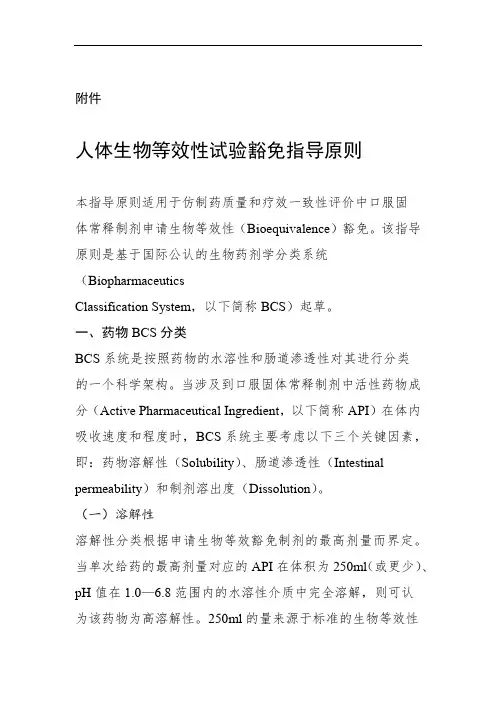
附件人体生物等效性试验豁免指导原则本指导原则适用于仿制药质量和疗效一致性评价中口服固体常释制剂申请生物等效性(Bioequivalence)豁免。
该指导原则是基于国际公认的生物药剂学分类系统(BiopharmaceuticsClassification System,以下简称BCS)起草。
一、药物BCS分类BCS系统是按照药物的水溶性和肠道渗透性对其进行分类的一个科学架构。
当涉及到口服固体常释制剂中活性药物成分(Active Pharmaceutical Ingredient,以下简称API)在体内吸收速度和程度时,BCS系统主要考虑以下三个关键因素,即:药物溶解性(Solubility)、肠道渗透性(Intestinal permeability)和制剂溶出度(Dissolution)。
(一)溶解性溶解性分类根据申请生物等效豁免制剂的最高剂量而界定。
当单次给药的最高剂量对应的API在体积为250ml(或更少)、pH值在1.0—6.8范围内的水溶性介质中完全溶解,则可认为该药物为高溶解性。
250ml的量来源于标准的生物等效性研究中受试者用于服药的一杯水的量。
(二)渗透性渗透性分类与API在人体内的吸收程度间接相关(指吸收剂量的分数,而不是全身的生物利用度),与API在人体肠道膜间—1——或者也可以考虑其他可以用来预测药物质量转移速率直接相关,体外上皮细胞在体内吸收程度的非人体系统(如使用原位动物、当一个口服药物采用质量平衡培养等方法)对渗透性进行分类。
显示在体内的吸收测定的结果或是相对于静脉注射的参照剂量,则%以上(并且有证据证明药物在胃肠道稳定性良好),程度≥85 可说明该药物具有高渗透性。
(三)溶出度口服固体常释制剂具有快速溶出的定义是:采用中国药典,转速为每分钟100)0931方法1 (篮法),转2015版附录通则(转,溶出介质体积7550或或是方法2(桨法),转速为每分钟或是不含0.1mol/L HCl)500ml(或更少),在溶出介质:(1为缓冲介质或是)pH6.8pH4.5缓冲介质;(3)酶的模拟胃液;(2的溶出均能达到标示量的分钟内API不含酶的模拟肠液中,30 85%以上。
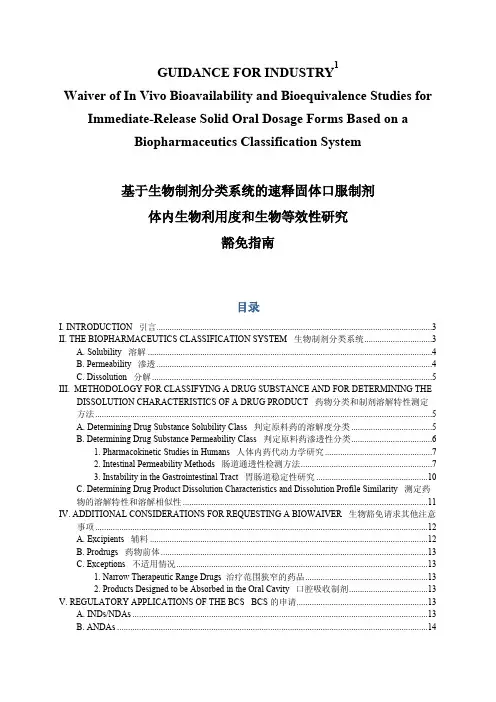
GUIDANCE FOR INDUSTRY1Waiver of In Vivo Bioavailability and Bioequivalence Studies for Immediate-Release Solid Oral Dosage Forms Based on aBiopharmaceutics Classification System基于生物制剂分类系统的速释固体口服制剂体内生物利用度和生物等效性研究豁免指南I. INTRODUCTION 引言 (3)II. THE BIOPHARMACEUTICS CLASSIFICATION SYSTEM 生物制剂分类系统 (3)A. Solubility 溶解 (4)B. Permeability 渗透 (4)C. Dissolution 分解 (5)III. METHODOLOGY FOR CLASSIFYING A DRUG SUBSTANCE AND FOR DETERMINING THE DISSOLUTION CHARACTERISTICS OF A DRUG PRODUCT 药物分类和制剂溶解特性测定方法 (5)A. Determining Drug Substance Solubility Class 判定原料药的溶解度分类 (5)B. Determining Drug Substance Permeability Class 判定原料药渗透性分类 (6)1. Pharmacokinetic Studies in Humans 人体内药代动力学研究 (7)2. Intestinal Permeability Methods 肠道通透性检测方法 (7)3. Instability in the Gastrointestinal Tract 胃肠道稳定性研究 (10)C. Determining Drug Product Dissolution Characteristics and Dissolution Profile Similarity 测定药物的溶解特性和溶解相似性 (11)IV. ADDITIONAL CONSIDERATIONS FOR REQUESTING A BIOWAIVER 生物豁免请求其他注意事项 (12)A. Excipients 辅料 (12)B. Prodrugs 药物前体 (13)C. Exceptions 不适用情况 (13)1. Narrow Therapeutic Range Drugs 治疗范围狭窄的药品 (13)2. Products Designed to be Absorbed in the Oral Cavity 口腔吸收制剂 (13)V. REGULATORY APPLICATIONS OF THE BCS BCS的申请 (13)A. INDs/NDAs (13)B. ANDAs (14)C. Postapproval Changes 批准后变更 (14)VI. DATA TO SUPPORT A REQUEST FOR BIOWAIVERS 生物豁免请求支持数据 (15)A. Data Supporting High Solubility 支持高溶解度的数据 (15)B. Data Supporting High Permeability 高渗透性支持数据 (15)C. Data Supporting Rapid and Similar Dissolution 快速及相似溶出支持数据 (16)D. Additional Information 其他信息 (17)ATTACHMENT A 附录A (18)I. INTRODUCTION 引言This guidance provides recommendations for sponsors of investigational new drug applications (INDs), new drug applications (NDAs), abbreviated new drug applications (ANDAs), and supplements to these applications who wish to request a waiver of in vivo bioavailability (BA) and/or bioequivalence (BE) studies for immediate release (IR) solid oral dosage forms. These waivers are intended to apply to (1) subsequent in vivo BA or BE studies of formulations after the initial establishment of the in vivo BA of IR dosage forms during the IND period, and (2) in vivo BE studies of IR dosage forms in ANDAs. Regulations at 21 CFR part 320 address the requirements for bioavailability (BA) and BE data for approval of drug applications and supplemental applications. Provision for waivers of in vivo BA/BE studies (biowaivers) under certain conditions is provided at 21 CFR 320.22. This guidance explains when biowaivers can be requested for IR solid oral dosage forms based on an approach termed the Biopharmaceutics Classification System (BCS).本指南给INDs、MDAs、ANDAs和增补申请主办方为速释固体口服制剂请求获得生物利用度和/或生物等效性研究豁免提供建议。
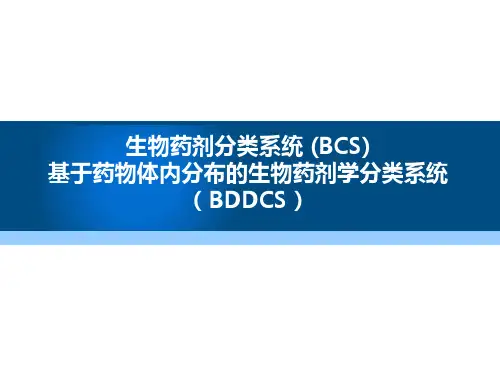
生物等效性试验豁免有一些药物,人们对其物理化学和生物性质,以及这些因素对生物等效性的影响已有足够的了解。
对于这些药物来说,就没有必要再进行生物等效性试验。
申报单位可以要求对这些药物生物的等效性试验豁免。
这类药物包括溶液制剂,某种药物产品中的某一些剂量,和生物药剂学分类系统(BCS)类药物。
1.溶液制剂对于某些药物来说,如皮肤外用溶液、鼻腔外用溶液、口服液、各类糖浆以及其它各类溶液型制剂,本身就已经证明是生物等效的,因此,可以免做生物等效性试验。
此类豁免的根据是药物的活性成分从剂型中完全释出(溶液),并且溶液中不含任何对药物的活性成分吸收有影响的辅料。
如果仿制药品采用了不同的辅料同时有可能会影响到其生物等效性的话,FDA将不予批准其生物等效性试验豁免的申请。
比如,山梨(糖)醇、甘露醇和木糖醇均为药品中常用的辅料。
食品工业中也常用之作为人工加甜剂。
这些辅料在胃肠道中的吸收度较差,可增加肠道的渗透压,影响胃肠道中水份的输送和肠道的运药时间,从而影响药物的吸收。
当肠道的运药时间降低的时候,药物分子在水溶液中被吸收的时间就会被降低,药物的吸收总量进而会减少。
造影学图象显示,具有渗透影响作用的成分对于上肠道的停留时间影响较小,而对下肠道的停留时间具有显著的影响。
渗透压的改变不仅会改变药物在肠道中的停留时间,还有可能影响到药物跨肠壁吸收的速度,进而导致穿透率较低的药物的吸收。
2.低剂量药物如果某种药物有多种剂量,且其中某种剂量的药物已通过体内的生物等效性试验,如其另外不同剂量的药物符合如下三个条件,则这些其它剂量的药物在体内的生物等效性试验可被予以豁免:(1)这些药物属同种剂型中的不同剂量;(2)与已通过体内的生物等效性试验的药物相比较,其它不同剂量的药物在活性成分及辅料成分上,都与已通过体内的生物等效性研究的药物成相似比例;(3)这些不同剂量的药物的体外溶出与已通过体内的生物等效性试验的体外溶出相类似。
3.生物药剂分类系统生物药剂分类系统(BCS)是基于药物本身的水溶性和通透性,对其进行科学分类的一种系统。
本指导原则适用于仿制药质量和疗效一致性评价中口服固体常释制剂申请生物等效性(Bioequivalence)豁免。
该指导原则是基于国际公认的生物药剂学分类系统(Biopharmaceutics Classification System,以下简称BCS)起草。
一、药物BCS分类BCS系统是按照药物的水溶性和肠道渗透性对其进行分类的一个科学架构。
当涉及到口服固体常释制剂中活性药物成分(Active Pharmaceutical Ingredient,以下简称API)在体内吸收速度和程度时,BCS系统主要考虑以下三个关键因素,即:药物溶解性(Solubility)、肠道渗透性(Intestinal permeability)和制剂溶出度(Dissolution)。
(一)溶解性溶解性分类根据申请生物等效豁免制剂的最高剂量而界定。
当单次给药的最高剂量对应的API在体积为250ml(或更少)、pH值在—范围内的水溶性介质中完全溶解,则可认为该药物为高溶解性。
250ml的量来源于标准的生物等效性研究中受试者用于服药的一杯水的量。
(二)渗透性渗透性分类与API在人体内的吸收程度间接相关(指吸收剂量的分数,而不是全身的生物利用度),与API在人体肠道膜间质量转移速率直接相关,或者也可以考虑其他可以用来预测药物在体内吸收程度的非人体系统(如使用原位动物、体外上皮细胞培养等方法)对渗透性进行分类。
当一个口服药物采用质量平衡测定的结果或是相对于静脉注射的参照剂量,显示在体内的吸收程度≥85%以上(并且有证据证明药物在胃肠道稳定性良好),则可说明该药物具有高渗透性。
(三)溶出度口服固体常释制剂具有快速溶出的定义是:采用中国药典2015版附录通则(0931)方法1 (篮法),转速为每分钟100转,或是方法2(桨法),转速为每分钟50或75转,溶出介质体积为500ml(或更少),在溶出介质:(1) L HCl或是不含酶的模拟胃液;(2)缓冲介质;(3)缓冲介质或是不含酶的模拟肠液中,30分钟内API的溶出均能达到标示量的85%以上。
附件人体生物等效性试验豁免指导原则本指导原则适用于仿制药质量和疗效一致性评价中口服固体常释制剂申请生物等效性(Bioequivalence)豁免。
该指导原则是基于国际公认的生物药剂学分类系统(Biopharmaceutics Classification System,以下简称BCS)起草。
一、药物BCS分类BCS系统是按照药物的水溶性和肠道渗透性对其进行分类的一个科学架构。
当涉及到口服固体常释制剂中活性药物成分(Active Pharmaceutical Ingredient,以下简称API)在体内吸收速度和程度时,BCS系统主要考虑以下三个关键因素,即:药物溶解性(Solubility)、肠道渗透性(Intestinal permeability)和制剂溶出度(Dissolution)。
(一)溶解性溶解性分类根据申请生物等效豁免制剂的最高剂量而界定。
当单次给药的最高剂量对应的API在体积为250ml(或更少)、pH值在1.0—6.8范围内的水溶性介质中完全溶解,则可认为该药物为高溶解性。
250ml的量来源于标准的生物等效性研究中受试者用于服药的一杯水的量。
(二)渗透性渗透性分类与API在人体内的吸收程度间接相关(指吸收剂量的分数,而不是全身的生物利用度),与API在人体肠道膜间质量转移速率直接相关,或者也可以考虑其他可以用来预测药物在体内吸收程度的非人体系统(如使用原位动物、体外上皮细胞培养等方法)对渗透性进行分类。
当一个口服药物采用质量平衡测定的结果或是相对于静脉注射的参照剂量,显示在体内的吸收程度≥85%以上(并且有证据证明药物在胃肠道稳定性良好),则可说明该药物具有高渗透性。
(三)溶出度口服固体常释制剂具有快速溶出的定义是:采用中国药典2015版附录通则(0931)方法1 (篮法),转速为每分钟100转,或是方法2(桨法),转速为每分钟50或75转,溶出介质体积为500ml(或更少),在溶出介质:(1)0.1mol/L HCl或是不含酶的模拟胃液;(2)pH4.5缓冲介质;(3)pH6.8缓冲介质或是不含酶的模拟肠液中,30分钟内API的溶出均能达到标示量的85%以上。
第一章1.代谢与排泄过程统称为()。
答案:消除2.药物的处置不包括()。
答案:吸收3.生物药剂学中的药物效应是指药物作用的结果,包括治疗效果、副作用和毒性。
()答案:对4.生物药剂学研究影响剂型体内过程的因素,主要是药物因素和剂型因素。
()答案:错5.生物药剂学的研究目的是()。
答案:设计合理的剂型;设计合理的制剂处方组成和工艺;评价制剂质量;临床合理用药第二章1.下列不属于促进扩散吸收机理的特点是()答案:消耗机体能量2.BSC对药物进行分类时,判断高溶解性的标准是()答案:最大应用剂量在不大于250ml的37℃,pH1-7.5的水性缓冲介质中完全溶解的药物。
3.下列哪种药物可用减小粒径的方法增加药物吸收答案:在消化道吸收受溶出速度影响的药物4.影响胃排空速度的因素有()答案:胃内容物的体积 ;食物的组成5.生物豁免原则是基于BCS科学原理对某些药物用体外溶出试验取代人体体内试验的生物等效性豁免管理原则。
()答案:对第三章1.不影响药物分布的因素有()答案:肝肠循环2.关于药物分布的叙述中,错误的是()答案:分布达平衡时,组织和血浆中药物浓度相等3.药物肝肠循环影响药物在体内的()答案:作用持续时间4.决定药物起效快慢的最主要因素是()答案:吸收速度5.能够反映出药物在体内分布的某些特点和程度的是()答案:表观分布容积第四章1.具有肝药酶活性抑制作用的药物是()答案:氯霉素2.下列关于肝药酶的叙述哪项是错误的()答案:存在于肝及其他许多内脏器官3.下列关于肝药酶诱导剂的叙述中错误的是()答案:可使被肝药酶转化的药物血药浓度升高4.促进药物生物转化的最主要酶系统是()答案:细胞色素P450酶系统5.不符合药物代谢的叙述是()答案:所有药物在体内均经代谢后排出体外第五章1.GFR的概念为()答案:肾小球滤过率2.药物排泄的主要器官是()答案:肾脏3.服用氯化铵酸化尿液后,大多数弱碱性药物()答案:解离多,排泄快4.油水分配系数大的药物不容易被肾小球滤过。
人体生物等效性试验豁免指导原则欧阳学文本指导原则适用于仿制药质量和疗效一致性评价中口服固体常释制剂申请生物等效性(Bioequivalence)豁免。
该指导原则是基于国际公认的生物药剂学分类系统(Biopharmaceutics Classification System,以下简称BCS)起草。
一、药物BCS分类BCS系统是按照药物的水溶性和肠道渗透性对其进行分类的一个科学架构。
当涉及到口服固体常释制剂中活性药物成分(Active Pharmaceutical Ingredient,以下简称API)在体内吸收速度和程度时,BCS系统主要考虑以下三个关键因素,即:药物溶解性(Solubility)、肠道渗透性(Intestinal permeability)和制剂溶出度(Dissolution)。
(一)溶解性溶解性分类根据申请生物等效豁免制剂的最高剂量而界定。
当单次给药的最高剂量对应的API在体积为250ml (或更少)、pH值在1.0—6.8范围内的水溶性介质中完全溶解,则可认为该药物为高溶解性。
250ml的量来源于标准的生物等效性研究中受试者用于服药的一杯水的量。
(二)渗透性渗透性分类与API在人体内的吸收程度间接相关(指吸收剂量的分数,而不是全身的生物利用度),与API在人体肠道膜间质量转移速率直接相关,或者也可以考虑其他可以用来预测药物在体内吸收程度的非人体系统(如使用原位动物、体外上皮细胞培养等方法)对渗透性进行分类。
当一个口服药物采用质量平衡测定的结果或是相对于静脉注射的参照剂量,显示在体内的吸收程度≥85%以上(并且有证据证明药物在胃肠道稳定性良好),则可说明该药物具有高渗透性。
(三)溶出度口服固体常释制剂具有快速溶出的定义是:采用中国药典版附录通则(0931)方法1 (篮法),转速为每分钟100转,或是方法2(桨法),转速为每分钟50或75转,溶出介质体积为500ml(或更少),在溶出介质:(1)0.1mol/L HCl或是不含酶的模拟胃液;(2)pH4.5缓冲介质;(3)pH6.8缓冲介质或是不含酶的模拟肠液中,30分钟内API的溶出均能达到标示量的85%以上。
生物药剂分类系统(BCS)及应用进展介绍
张宁;平其能
【期刊名称】《中国新药杂志》
【年(卷),期】2008(17)19
【摘要】生物药剂分类系统是根据药物的溶解性和渗透性对药物进行分类的一种科学框架,目前FDA、WHO和EMEA都接受了这种分类概念.文中比较了不同管理当局对于生物药剂分类系统(BCS)的定义以及BCS在药品注册申报中支持生物等效免除的应用情况,综述了不同管理当局对于BCS的认识并提出了展望.
【总页数】4页(P1655-1658)
【作者】张宁;平其能
【作者单位】中国药科大学国际医药商学院,南京,210009;国家食品药品监督管理局药品审评中心,北京,100038;中国药科大学国际医药商学院,南京,210009
【正文语种】中文
【中图分类】R945
【相关文献】
1.生物药剂在造纸工业废水处理系统中的应用进展 [J], 肖鹏;张红岩;江淦福
2.兽用药物生物药剂学分类系统(BCS)的研究进展 [J], 李振霞;罗万和;李超;周凯翔;潘源虎;陶燕飞;谢书宇
3.黄连提取物的中药生物药剂学分类系统探讨 [J], 刘越滇; 蔡欣廷; 倪文颖; 卢恩恩
4.基于药物溶解性和渗透性测定的生物药剂分类系统在兽药制剂研发的应用前景[J], 王丽平;刘洋;宋阳
5.药审中心公开征求ICH指导原则《M9:基于生物药剂学分类系统的生物等效性豁免》意见 [J],
因版权原因,仅展示原文概要,查看原文内容请购买。